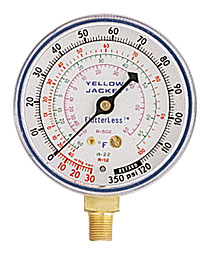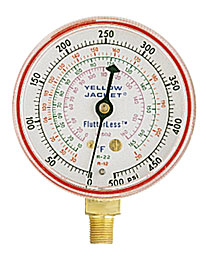Basic Charging Techniques
Charging an a/c system requires the use of gauges to monitor system pressure. The most common tool used to check system pressure is the manifold gauge set. There are many variations of gauge sets on the market, but they all share many of the same traits.The basic manifold gauge set has three hoses. Two hose will be attached to the service ports on the vehicle during service. Each hose has its own identifying color. The hose intended for the low pressure service port is blue. The hose intended for the high pressure service port is red. The middle hose will be yellow. The yellow hose will be attached to the refrigerant cylinder while charging or the vacuum pump when the system is being evacuated of air and moisture.
Your manifold gauge set will have a corresponding gauge and control knob for each service hose. Like the color of the hoses, the gauges and control knobs will usually be colored to indicate high or low pressure.
| The low side pressure gauge is used to monitor the low pressure side of the a/c system. This gauge is a compound gauge, which means it can be used to measure pressure or vacuum. The large black numbers around the outside of this gauge indicate pressure in pounds per square inch (PSIG), and the large red numbers near the bottom indicate vacuum in inches of mercury. The smaller scales near the middle of the gauge list the temperature relationship of different refrigerants. The gauge pictured here lists the temperature of R12, R22, and R502. Regardless of which refrigerant is being used, the scale designated as PSI is the one used to read system pressures when charging and diagnosing an a/c system. The working pressure of this gauge is from 0 to 120 PSI. |  |
 |
The red, high side gauge is used to measure the high pressure side of the a/c system. This gauge has no markings that indicate vacuum. It reads positive pressure only. The working pressure of this gauge is also much higher than the low side gauge pictured above. Notice the scale on this gauge reads from 0 to 500 PSI. |


